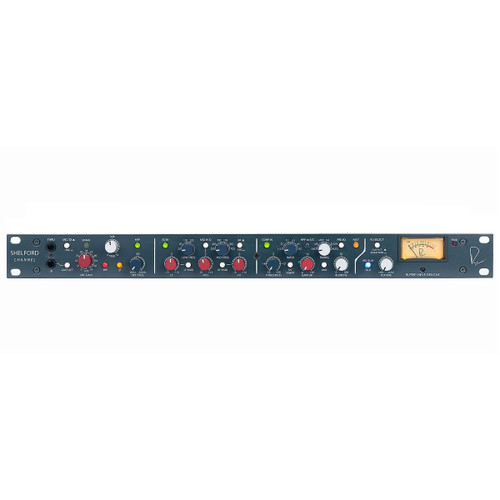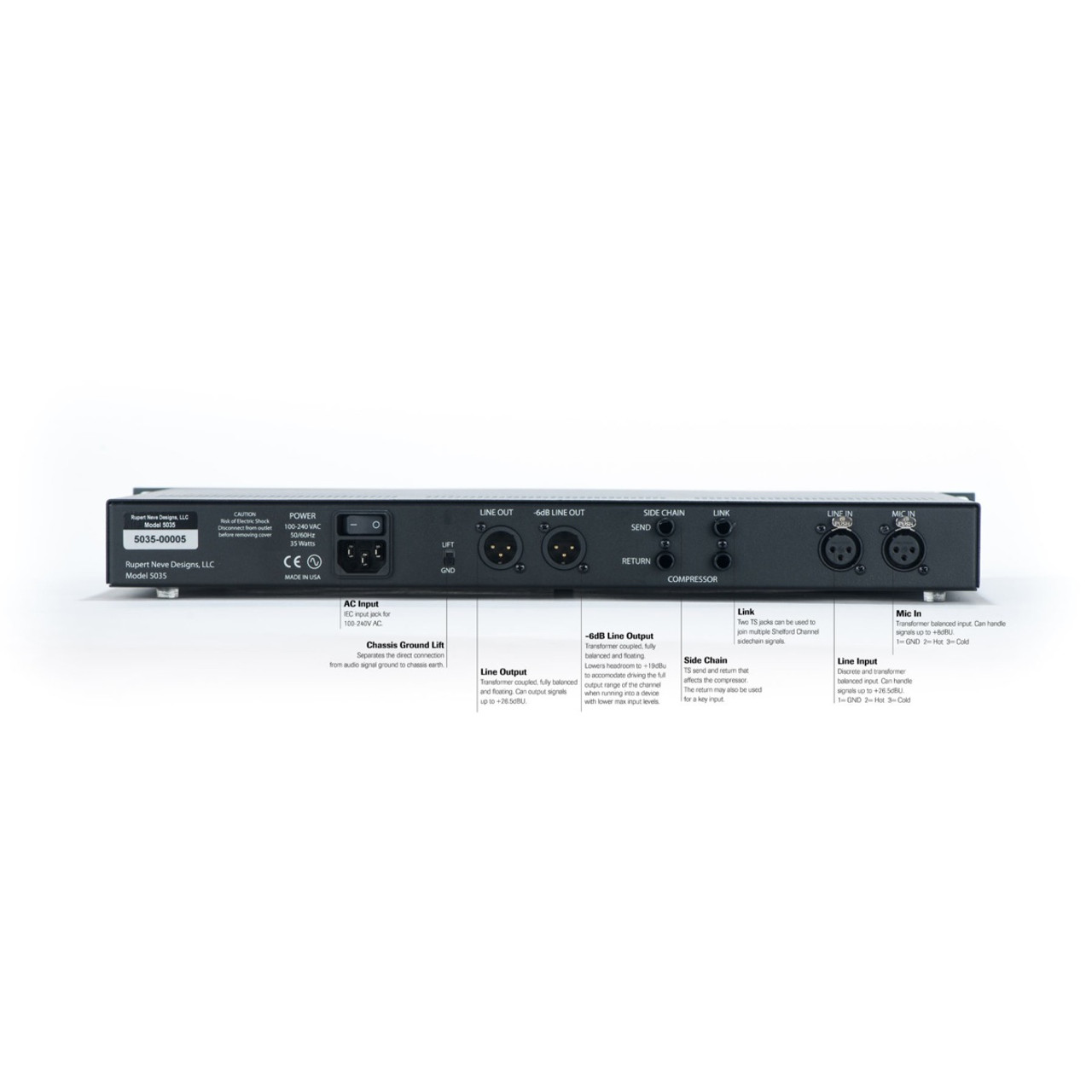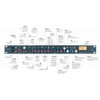The Rupert Neve Shelford Channel is over fifty years in the making! The Shelford Channel is the definitive evolution of the original technologies in Rupert's classic console modules like the 1073, 1064, 1081 & 2254, thoughtfully advanced and refined for the 21st century studio.
The Rupert Neve Designs Shelford Channel is built around Rupert Neve's first new transformer-gain, class-A microphone preamplifier in over 40 years, the "best-of-the-classics" inductor EQ section from the Shelford 5052, a tone-packed Diode bridge compressor, the analog power of variable Silk saturation, a new dual-tap transformer output stage for maintaining headroom or allowing the full driving of the Channel without clipping standard converters, and twice the operating voltage of vintage designs. With richly-colored tonal options for making bold statements with your music, and precisely-engineered detented controls for recall, the vintage-inspired Shelford Channel maintains the soul of Rupert's classic designs with new levels of versatility, delivering what can only be described as the combined essence of fifty years of Rupert Neve's designs.
Like Rupert's designs from his time in Little Shelford , the Shelford Channel's preamplifier uses a directly-coupled transformer input with gain provided by the custom transformer itself a first in over 40 years for Rupert Neve. This new custom-designed input transformer, along with its careful integration with the surrounding circuitry, is critical to the Channel's bold and instantly recognizable character.
With this classic topology, the input transformer design is extraordinarily challenging, and the RN4012 transformer utilized in the Channel went through many generations before Mr. Rupert Neve was satisfied. This transformer provides the first 15dB of gain, with the rest of the 72dB of gain provided by the discrete, class-A amplifier blocks controlled by a stepped attenuator and precision trim pot. Whereas Rupert's more modern designs (e.g. the Portico Series) utilize a combination of TLAs (Transformer-Like Amplifiers) followed by an input transformer for pristine low & high frequency detail and galvanic isolation (see comparing input topologies notes), the Shelford Channel's design directly couples the input transformer to the microphone line. When this new transformer is combined with its surrounding class-A input amplifiers, the result is the unmistakably smooth high and low frequencies of the most famous vintage modules in the world, yet with incredibly low noise and superior isolation. The mic pre section also includes a sweepable 20-250Hz high-pass filter, Mic / Line selection, 48V phantom power, and polarity reverse.
Similarly to the input stage, the new output stage is designed to provide the texture and power of Rupert's classics while allowing for significantly more versatility in tone. The dual-tap output for the Channel's RN2042 square-core output transformer creates both high and low headroom outputs without compromising the channel's performance. The high headroom tap is designed capture a more pristine sound at high levels, avoiding non-linear coloration of the output stage and taking full advantage of the Shelford's higher voltage design. The low headroom tap however is optimized to allow an engineer to drive the full voltage range of the Channel adding dynamic tone with these same non-linear colorations without clipping most professional interfaces. On drums, vocals, guitars and other instruments, this output lets you easily hit the transformer's "sweet-spot" of non-linear harmonic content, which can bring a recorded performance to life in a way that other effects can't.
Another advantage of the output stage versus vintage modules is the addition of the variable Silk circuitry, which allows complete control over the harmonic content and saturation of the output transformer. With Silk disengaged, the output is modern and pristine, yet still retains Rupert's signature larger-than-life transformer sound. When engaged, the harmonic content predominantly 2nd order and 3rd order with no high order distortion can be dialed up to several times beyond that found in his vintage units like the 1073. This is further controlled with Silk Red and Blue modes, which emphasize harmonic content generated by the source's high frequencies (Red) or low frequencies (Blue).
Rupert Neve Shelford Channel Features
- Signature Silk/Texture
- Universal Power Supply
- Instrument DI with Thru Put
- Side Chain Insert
- Compressor Blend Pot for Parallel Processing
- VU Meter
Rupert Neve Shelford Channel Specifications
- Mic Preamp
- Input Impedance: 2,200ohms
- Maximum Input:
- +21.5dBu from 150Hz to 22kHz
- +8dBu 20Hz to 22kHz
- Gain Steps: 0-66dB (in 12 position 6dB steps)
- Noise:
- Un-weighted, 22Hz-22kHz, source impedance 150 Ohms balanced.
- Main Out @ unity gain -100.9dBu
- -6dB Out @ unity gain -106.6dBu
- +30dB gain (Main Out) -91.37dBu
- +66dB Gain (Main Out) -64.1dBu
- Equivalent Input Noise -121.37dBu
- Frequency Response: +/-0.25dB from 17Hz to 45kHz
- Input Impedance: 2,200ohms
- Direct Input
- Maximum Input: 8dBu @ 20Hz to 120kHz
- Noise @ Main Output: -100dBu (22Hz to 22kHz)
- Line Input
- Maximum Input Level: +30.5dBu 20Hz to 30kHz
- Total Harmonic Distortion and Noise:
- @ 1kHz, +20dBu output level, no load. Better than 0.002%
- @ 20Hz, +20dBu output level, no load. 0.05% Typical (2nd and 3rd harmonic)
- Noise @ Main Output: -101.1dBu Un-weighted, 22Hz-22kHz, source impedance 40 Ohms balanced, no load.
- Frequency Response: +/- 0.25dBu from less than 10Hz to 110kHz / -0.32dB @ 120kHz
- Maximum Output Level: +26dBu @ 16Hz to 20kHz
- Total Harmonic Distortion and Noise with SILK engaged:
- RED
- TEXTURE @ min @ 100Hz, +20dBu input level, no load 0.0131%, mostly 3rd harmonic (typical)
- TEXTURE @ max @ 100Hz, +20dBu input level, no load 1.66%, mostly 2rd harmonic (typical)
- BLUE
- TEXTURE @ min @ 100Hz, +20dBu input level, no load 0.0079%, mostly 3rd harmonic (typical)
- TEXTURE @ max @ 100Hz, +20dBu input level, no load 0.941%, mostly 2rd harmonic (typical)
- RED
- High Pass Filter: Continuously variable swept frequency from 20Hz to 250Hz. @ Slope: 12dB/Octave
- EQ Noise: Un-weighted, 22Hz-22kHz, -92dBu
- Signal Present / Overload Indicator
- Signal Present: Illuminates GREEN when input stage signal level reaches -20dBu
- Overload: Illuminates RED when input stage signal level reaches -23dBu
- Diode Bridge Compressor:
- Noise (BW 22Hz-22kHz): 0 dB Makeup Gain: -84.5 dBu / +20 dB Makeup Gain: -64.2 dBu
- Time Constants: Measurements taken represent full range achievable between 1.5:1 Ratio and 8:1
- Ratio setting:
- 0 dBu I/P 1kHz Burst Tone used for all recorded measurements
- Fast (TC1): Attack 180µS-1.8mS // Release 100mS-150mS
- MedFast (TC2): Attack 750µS-5.25mS // Release 160mS-250mS
- Med (TC3): 2.7mS-18mS // Release 350mS-525mS
- MedSlow (TC4): 4.6mS-38mS // Release 600mS-1 S
- Slow (TC5): 11mS-72.5mS // Release 800mS-1.25 S
- Auto (TC6): 5.75mS-35.5mS // Release T1 400mS-850mS, T2 TBD
- Fast Mode Multiplier: Modifies aforementioned TCs by 70% of original value
- Ratio setting:
Rupert Neve Shelford Channel Includes
- Rupert Neve Shelford Channel
- Power Cable
- Manual
- 1 Year Warranty
Videos Hide Videos Show Videos
2 Reviews Hide Reviews Show Reviews
Write a Review
























 Sign Up for exclusive sales and offers!
Sign Up for exclusive sales and offers!